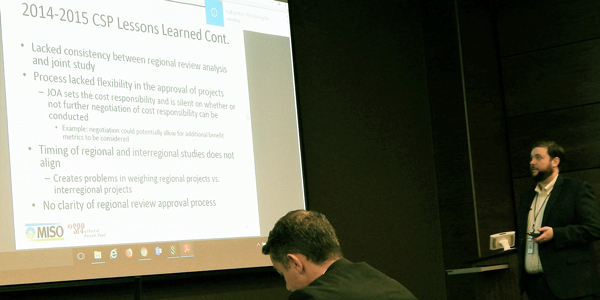By Amanda Durish Cook
Stakeholders on Monday said they remain skeptical of a MISO-SPP plan to eliminate the RTOs’ joint model in favor of using their respective regional models to estimate and divide the cost of interregional projects.
The RTOs announced the plan last month. (See MISO, SPP Loosen Interregional Project Requirements.) They will also examine all types of interregional projects by both an adjusted production cost (APC) and avoided cost benefit metrics, a departure from current practice. Currently, only reliability interregional projects are evaluated using both metrics. Public policy interregional projects are limited to an avoided cost metric while economic interregional projects are limited to an APC metric.
But stakeholders are still questioning how MISO and SPP will ensure equitable cost allocation between the RTOs absent a joint model.
SPP Interregional Coordinator Adam Bell said some stakeholders may have misunderstood elements of the proposal after its was revealed in July, including a mistaken assumption that the RTOs would use their regional models to calculate each other’s benefits and cost allocation. He confirmed that each RTO would calculate only its own benefit from a proposed project.
“SPP will not be calculating MISO’s benefit,” Bell reassured stakeholders during an Aug. 27 MISO-SPP Interregional Stakeholder Planning Advisory Committee conference call.
However, staff said they will not create identical adjusted production cost calculations in their regional models, which multiple stakeholders say are a must if project candidates are to be judged consistently across RTOs.
“There are differences [in our regional models],” Bell said. “We are not proposing that the regional calculations of adjusted production costs be exactly the same. … It’s kind of a situation of who’s to say which has the better APC benefit calculation. They are different, and that’s not something we’re proposing to change at this point.”
MISO Planning Adviser Davey Lopez said the unique APCs used in the regional models only highlighted the need to remove the joint model. He said the RTOs should be free to evaluate interregional projects in the same manner that they evaluate regional projects.
“In my view, I think that’s extremely equitable cost allocation,” Lopez said, adding that both methods have been accepted by FERC.
“SPP values transmission the way SPP values transmission, and the same can be said of MISO. … We’re going to be making decisions based on how each region values transmission,” Bell explained.
RTO staff also pointed out that under the existing interregional process, project candidates must still undergo disparate regional reviews in addition to the joint model.
But some stakeholders said that under the new process, MISO and SPP have the potential to get hung up on what portion of project costs the other one owes.
“What I fear is going to result from this — because of the way each is going to calculate benefits — that they’ll view their share of the cost of these benefits as being unfair,” said The Wind Coalition’s Steve Gaw, adding that interregional projects might still not be built as a result.
Lopez said that it was difficult to envision that projects that have passed benefit metrics on both sides of the seam would be passed up because one RTO feels slighted over costs.
“I’ve been to too many of these [meetings] to have faith in that being the case,” Gaw responded.
However, MISO and SPP say they are open to aligning their regional models to examine project benefits over the same number of years. MISO’s regional model currently gauges new transmission value for the first 20 years of the life of a facility, as the MISO-SPP joint operating agreement prescribes, while SPP looks over 40 years.
Lopez said the RTOs will continue to discuss the benefit timelines, though he added that he was not suggesting that MISO would use anything other than a 20-year timeline. He said MISO viewed the question as both RTOs using the JOA-prescribed timeline or continuing to rely on the existing processes with differing timelines. Multiple stakeholders said the RTOs should align the timescale.
MISO and SPP will continue to work on the new interregional project process through fall, with final JOA revisions targeted in October or November.




